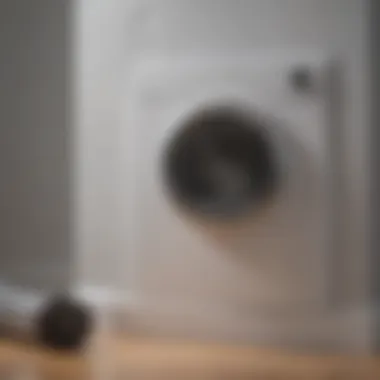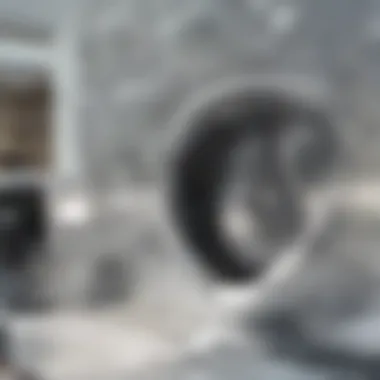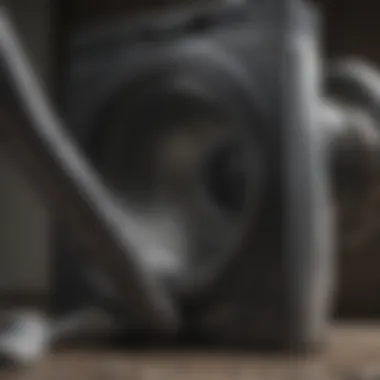Ultimate Guide to Dryer Vent and Air Duct Cleaning


Intro
Cleaning dryer vents and air ducts is a task often overlooked by homeowners. However, this maintenance is crucial for not just enhancing indoor air quality, but also for ensuring fire safety. Lint buildup in dryer vents can lead to significant hazards. Similarly, dust accumulation in air ducts can adversely affect health. Thus, understanding the processes involved in cleaning these systems becomes essential.
This guide aims to provide a clear and structured approach to cleaning dryer vents and air ducts. It will discuss methods for cleaning, the equipment required, safety precautions, and the frequency with which these tasks should be performed. By the end of this article, readers will be equipped with knowledge to maintain a cleaner, safer home environment.
Prelims to Dryer Vents and Air Ducts
Maintaining the cleanliness of dryer vents and air ducts is crucial for any homeowner. Both systems play distinct yet essential roles in ensuring a safe and comfortable living environment. Understanding these components can help in recognizing their importance and the need for regular cleaning.
Understanding Their Functionality
Dryer vents are responsible for expelling hot, moist air generated during the drying of clothes. A properly functioning dryer vent allows the moisture to escape efficiently, preventing the buildup of lint and other debris that can lead to fires or inefficiencies. Conversely, air ducts circulate heated or cooled air throughout a home, affecting indoor air quality and comfort levels. They should remain unblocked and clean to facilitate optimal airflow.
When either system becomes obstructed, it hinders their functionality and can pose serious safety risks. For example, clogged dryer vents can cause your clothes dryer to overheat and potentially ignite a fire. Similarly, dirty air ducts can trap dust and allergens, impacting indoor air quality negatively. Thus, recognizing how these systems work is the first step towards taking the necessary actions to maintain them.
Importance of Regular Maintenance
Engaging in regular maintenance of your dryer vents and air ducts carries several benefits. For one, it promotes operational efficiency, reducing wear and tear on your appliances. Most importantly, it drastically minimizes safety hazards associated with fire risks and poor air quality.
Many experts recommend checking dryer vents at least once a year. Inspections help identify blockages or build-up, allowing for timely intervention. Air ducts also require similar attention to prevent the accumulation of dust, mold, and other allergens.
Failing to maintain these systems can lead to higher energy bills, unhygienic air conditions, and potential appliance failure. Therefore, understanding the importance of maintaining cleanliness is vital for ensuring longevity in your home’s systems.
Signs of Clogged Vents and Ducts
Recognizing the signs of clogged vents and ducts is crucial for maintaining the efficiency of your dryer and HVAC system. These obstructions can impact both performance and safety. Ignoring these warning signals not only compromises air quality but can also lead to increased energy costs and potential hazards.
Unusual Odors
One of the first signs that your vents or ducts may be clogged is the presence of unusual odors emanating from your appliances. These smells can vary from musty or moldy scents to burning smells. The accumulation of lint, dust, and even moisture can create an environment conducive to mold growth, resulting in unpleasant odors. Conversely, if there is a burning odor, it can indicate that the dryer is overheating due to lint buildup, which poses a fire risk.
Addressing these odors promptly can prevent further complications and is essential for your safety.
Inefficiency in Operation
Another significant indicator of clogged vents and ducts is the inefficiency in the operation of your appliances. If the dryer is taking longer than usual to dry clothes, or if your HVAC system struggles to maintain a desired temperature, this may signal a blockage. Clogged ducts restrict airflow, which in turn hampers the effectiveness of the systems. Additionally, sporadic or inconsistent heating or cooling effects can be directly traced back to obstructions within the air pathways.
Increased Drying Times
Finally, one of the most telling signs that dryer vents are blocked is consistently increased drying times for your laundry. When dryer vents are clogged, the airflow decreases significantly. Consequently, clothes will take much longer to dry. If your dryer takes more than one cycle to adequately dry a load, this issue should be investigated. Not only does this increase your utility bills, but it puts additional strain on your appliance, potentially leading to costly repairs down the line.
Tools and Equipment Needed for Cleaning
Understanding the optimal tools and equipment required for cleaning dryer vents and air ducts is crucial. The cleaning process can be labor-intensive, and using the right tools reduces effort while maximizing effectiveness. This ensures a thorough cleaning that enhances the efficiency of your appliances and improves air quality in your home.


Basic Cleaning Tools
When embarking on the journey of cleaning dryer vents and air ducts, several basic tools are essential. These tools not only facilitate the process but also ensure that you can conduct a thorough job without requiring excessive expenditures on specialized equipment. Here are some of the primary tools you will need:
- Screwdriver: For removing covers and access panels, a sturdy screwdriver is imperative.
- Vacuum Cleaner: A vacuum equipped with a hose attachment is essential for sucking dust and debris effectively. Ensure that it has a high-efficiency particulate air (HEPA) filter for optimal performance.
- Brushes: Flexible vent brushes can reach deeper into ducts or vents to dislodge buildup. Brushes come in various sizes to cater to different vent widths.
- Flashlight: A good quality flashlight assists in illuminating dark corners, helping to identify blockages or areas needing attention.
- Tarps or Drop Cloths: These protect your flooring and furnishings from dust and debris that may escape during the cleaning process.
By utilizing basic cleaning tools wisely, one can significantly enhance the overall outcome of the cleaning project.
Specialized Cleaning Equipment
Apart from basic tools, there is specialized cleaning equipment that can dramatically improve the efficacy of your cleaning efforts. Investing in such equipment can lead to a deeper clean and minimizes health risks associated with poor indoor air quality. Key specialized tools include:
- High-Powered Vacuum System: These vacuums can extract a significant amount of debris from ducts with powerful suction capabilities. They are especially effective for large homes with expansive duct networks.
- Air Duct Inspection Camera: A small camera on a flexible rod allows for visual inspection of the duct interior without extensive disassembly. This helps identify blockages or mold development.
- Blower Tool: A blower can help push through stuck debris, clearing buildup quickly. It is particularly useful in longer duct runs where a vacuum may not reach effectively.
- Chemical Biocides: In cases of mold or severe contamination, specialized cleaning products may be needed. However, use them cautiously and be aware of indoor air quality concerns.
Proper use of specialized cleaning equipment, alongside basic tools, ensures a comprehensive cleaning regime. This dual approach can lead to not only cleaner vents but also enhanced appliance efficiency and healthier indoor environments.
Regular cleaning and maintenance of dryer vents and air ducts are vital for home safety and appliance longevity.
By addressing these factors diligently, homeowners can stay proactive, thereby preventing hazards and ensuring a clean, well-functioning home.
Step-by-Step Process for Cleaning Dryer Vents
Cleaning dryer vents is essential for maintaining the efficiency of the appliance. It helps reduce the risk of fire and ensures optimal performance. A well-cleaned vent can increase the lifespan of the dryer and improve the quality of indoor air. Understanding this process is beneficial as it empowers homeowners to take proactive measures in maintaining their systems, which can save time and money in the long run.
Preparing the Area
Before starting the cleaning process, it is crucial to prepare the area. Clear any objects near the dryer and ensure there is sufficient space to work. This preparation can prevent accidents and makes the cleaning process smoother. Additionally, gathering all necessary tools and equipment in one place can aid efficiency during the cleaning steps.
Disconnecting the Dryer
Disconnecting the dryer from the power supply is a critical step in ensuring safety. Unplugging the dryer prevents any electrical hazards that could arise during cleaning. Some may prefer to turn off the circuit breaker instead; however, unplugging is a more direct method. It is also important to detach the vent from the dryer. This disconnection allows for a more thorough cleaning of the entire duct system without hindrances.
Cleaning the Vent Duct
Cleaning the vent duct can be accomplished effectively with two main methods: using a vacuum and using a vent brush.
Using a Vacuum
Using a vacuum is a straightforward and effective method for cleaning dryer vents. A vacuum can easily remove lint and debris from the ductwork. The suction power is beneficial as it can reach deep into the ducts where other tools may not be effective. It's a popular choice among homeowners because it minimizes mess and can be used regularly for maintenance. However, it may not remove stuck debris completely in some cases, requiring additional methods to ensure the vent is entirely clean.
Using a Vent Brush
A vent brush is another useful tool for cleaning dryer vents. This brush can reach areas that a vacuum might miss. The bristles are designed to capture lint effectively while also loosening debris stuck to the duct walls. Many people find vent brushes to be beneficial as they provide a more thorough clean by physically dislodging buildup. The downside is that it requires more effort and may take longer than using a vacuum, but it compensates with its thoroughness.
Reconnecting Everything
After cleaning, reconnecting everything is the final step. First, ensure that all parts are completely dry before reattaching. Properly reconnecting the vent to the dryer is essential to ensure effective airflow. Once secured, plug the dryer back in or turn on the circuit breaker. Testing the dryer after completion helps check if the cleaning has improved performance.


Step-by-Step Process for Cleaning Air Ducts
Cleaning air ducts is essential for maintaining good air quality and ensuring the efficiency of your heating and cooling systems. Over time, dust, allergens, and debris accumulate in ducts, affecting indoor air quality. A thorough cleaning process not only removes these contaminants but also promotes better airflow, leading to improved energy efficiency.
Assessing the Ductwork
Before initiating the cleaning process, an assessment of the ductwork is important. Inspecting the ducts for damage, blockages, and dirt buildup helps in determining the extent of cleaning needed. Look for
discoloration or mold around ducts or vents, as these are indications of potential issues. Also, ensure the duct system is accessible, as obstructions can complicate the cleaning process. Any visual inspection can provide insights on necessary repairs and the appropriate cleaning techniques to employ.
Preparing for Cleaning
Preparation is key to an effective duct cleaning process. Start by turning off the HVAC system. It ensures safety and prevents dust from circulating during the cleaning. Next, clear the area around vents and registers to allow easy access. If possible, cover furniture and floors to protect against falling debris. Make sure all needed tools and equipment, such as vacuums and brushes, are ready before starting to avoid interruptions. This initial setup significantly enhances the efficiency of the cleaning process.
Utilizing a Blower System
Using a blower system is an effective method for cleaning ducts. A high-powered blower can dislodge dirt and debris clinging to the duct walls. This process typically involves inserting the blower into the ductwork and activating it to push contaminants toward the ducts' exit points. Dust is then vacuumed or collected at the end. Ensure that the system you are using is suited for your particular duct size and type. Proper handling of the blower can prevent damage to the duct and ensure thorough cleaning.
Sealing and Insulating Ducts
After cleaning, sealing and insulating ducts becomes essential. Sealing any leaks prevents air loss, which can lead to inefficiency in your HVAC system. Insulating ducts, especially those running through unconditioned spaces, minimizes heat loss, enhancing system performance. Use appropriate materials, such as duct tape or mastic sealant, to ensure a long-lasting seal. This step not only helps in improving air quality but also can reduce energy bills in the long term.
Safety Considerations
Cleaning dryer vents and air ducts is not only about maintaining efficiency; it is also about ensuring safety. Neglecting safety can lead to accidents that are easily avoidable. By following specific guidelines, you can mitigate risks associated with the cleaning process, creating a safer environment for you and your family.
Identifying Hazards
Before you start cleaning, it’s crucial to recognize potential hazards. Here are some common risks:
- Electrical Hazards: When removing the dryer from its outlet or handling any equipment, be aware of potential electrical shock. Always turn off power before doing any work.
- Fire Risks: Clogged vents can trap lint and debris, leading to overheating and a significant fire hazard. Identifying early signs of buildup can protect against this danger.
- Chemical Exposure: If using chemical cleaners, ensure proper ventilation. Some chemicals may produce harmful fumes that are not safe to inhale.
- Physical Injuries: Heavy equipment or awkward positions can lead to sprains or other injuries. Be mindful of your posture and how you lift objects.
By understanding these hazards, you can develop strategies to minimize risk during the cleaning process. For instance, using tools specifically designed for this task can help eliminate many concerns.
Using Protective Gear
Taking precautions is essential in ensuring safety during cleaning. Using protective gear allows you to work confidently without exposing yourself to unnecessary risks. Here are some recommended items:
- Gloves: Protect your hands from sharp edges, lint, and cleaning chemicals.
- Safety Glasses: Prevent irritants from getting into your eyes, especially when working in dusty or confined spaces.
- Dust Masks: Fine particles can be harmful if inhaled. Wearing a mask helps reduce exposure to allergens and dust.
- Knee Pads: These can help protect your knees if you are working on the floor for extended periods.
Employing protective gear is a straightforward way to safeguard yourself while performing this necessary work.
"Safety is not just a priority, it is a practice. Investing in safety gear is an investment in your well-being."
By keeping these considerations in mind, you can ensure a smoother, safer cleansing process for your dryer vents and air ducts.
Benefits of Professional Cleaning Services


Maintaining clean dryer vents and air ducts is crucial to ensure safety and efficiency in homes. While some homeowners might consider a DIY approach, there are distinct advantages to hiring professional cleaning services. Professionals not only possess the skills required but also understand the nuances of air duct and dryer vent cleaning that are easily overlooked by an average homeowner. This section explores the main benefits of using professional cleaning services.
Expertise and Experience
One of the most significant benefits of hiring professionals lies in their expertise. Trained technicians have extensive experience in dealing with various types of duct systems and dryers. They can easily identify issues that may not be apparent to an untrained eye. This includes recognizing signs of wear and tear, potential blockages, and areas prone to lint buildup.
Professionals are equipped with up-to-date knowledge of best practices and regulations within the industry. They often undergo regular training to stay informed on new technologies and cleaning techniques.
Their familiarity with the latest methods ensures that the cleaning process is thorough and effective. Such expertise minimizes the risk of damage to ducts or dryers, which can occur during improper cleaning.
Access to Advanced Equipment
Cleaning dryer vents and air ducts efficiently requires specialized tools. Professional cleaning services invest in advanced equipment that may not be practical for homeowners to purchase. For instance, high-powered vacuums, rotary brushes, and specialized blowers are designed to remove dust, debris, and lint more effectively than standard household tools.
These tools enable professionals to reach deep inside vents and ducts, ensuring every corner is cleaned. This is particularly important in preventing fire hazards that can arise from accumulated lint within dryer vents.
Moreover, using advanced equipment can significantly reduce cleaning time while enhancing the effectiveness of the process. Professionals have the right tools for different jobs, providing a level of efficiency that benefits the overall maintenance of the home’s air quality and safety.
"Regular maintenance performed by professionals leads not only to cleaner air, but also to prolonged lifespan of your appliances."
Maintaining Clean Vents and Ducts
Maintaining clean dryer vents and air ducts is crucial for the efficient operation of home appliances and for ensuring overall indoor air quality. Accumulated lint in dryer vents can lead to reduced airflow, increased energy consumption, and heightened fire risk. Similarly, unclean air ducts can circulate dust, allergens, and other contaminants throughout your living spaces, potentially harmful to health. Regular maintenance not only enhances the performance of these systems but also contributes to the longevity of your appliances. An effective maintenance routine can save homeowners time and money in the long run.
Regular Inspection Schedule
Creating a regular inspection schedule is essential for keeping both dryer vents and air ducts in optimal condition. Homeowners should aim to inspect their dryer vents at least once every six months, while air ducts should ideally be checked annually. During these inspections, look for obstructions, dirt build-up, or signs of damage. Early detection of issues can prevent larger problems down the road and maintain airflow efficiency. For instance, excessive lint in dryer vents can dramatically increase drying times and energy costs. If you notice any excessive debris, take action quickly.
An effective inspection can identify problems before they escalate into costly repairs.
Preventive Measures
Taking preventive measures is another key aspect of maintaining clean vents and ducts. Here are several strategies to consider:
- Use lint traps: Always remember to clean the lint trap before and after every use of the dryer. This simple step can significantly reduce lint buildup in the vents.
- Utilize exhaust hoods: Make sure your dryer has an exhaust hood that opens correctly. A well-functioning hood prevents animals and debris from blocking the vent.
- Consider airflow: Ensure nothing obstructs the vent's exterior outlet. A clear outlet allows for proper airflow.
- Schedule professional cleaning: Engaging professionals for a thorough cleaning of the vents and ducts every few years helps maintain their efficiency.
- Monitor appliance performance: Keep an eye on the performance of your dryer and HVAC system. If they start to work harder than usual, it might indicate a buildup that requires attention.
Implementing these preventive measures can lead to fewer repairs, improved energy efficiency, and a healthier living environment. A proactive approach to maintenance will enhance the comfort level in your home.
Epilogue
The conclusion of this article emphasizes the critical nature of cleaning dryer vents and air ducts. This subject matter is not merely about maintaining appliances; it touches on broader themes of safety, efficiency, and air quality. Through consistent upkeep, homeowners can significantly reduce the risk of household fires that originate from clogged dryer vents. Furthermore, clean ducts can greatly enhance indoor air quality, providing a healthier environment.
Summarizing Key Takeaways
As we wrap up, it is important to digest the key takeaways:
- Regular Maintenance is Essential: Addressing the cleanliness of vents and ducts should not be an afterthought. A routine inspection and cleaning schedule minimizes hazards and enhances performance.
- Signs of Issues: Familiarize yourself with the unusual signs that indicate a problem, such as excessive drying times or unexpected odors. Identifying these issues early can save time and resources.
- Professional Help: While DIY methods are valuable, the expertise of professional cleaning services can be beneficial. They have advanced tools and experience that significantly streamline the cleaning process.
- Ongoing Care: After the cleaning, it is vital to implement preventive measures. Consider using lint traps and ensuring proper airflow to keep systems running smoothly.
Encouraging Action on Maintenance
It is not enough to simply acknowledge the importance of cleaning. Homeowners must actively engage in these maintenance practices. Set a schedule for inspections and cleaning—consider every six months, or more frequently if usage is heavy.
- Create a Checklist: Have a list of tasks to perform regularly. This can include checking the vent for clogs, updating filters, and ensuring that all connections are secure.
- Educate Household Members: Inform everyone in the household about the significance of maintaining clean vents and ducts. Knowledge can prevent careless habits that lead to neglected appliances.







